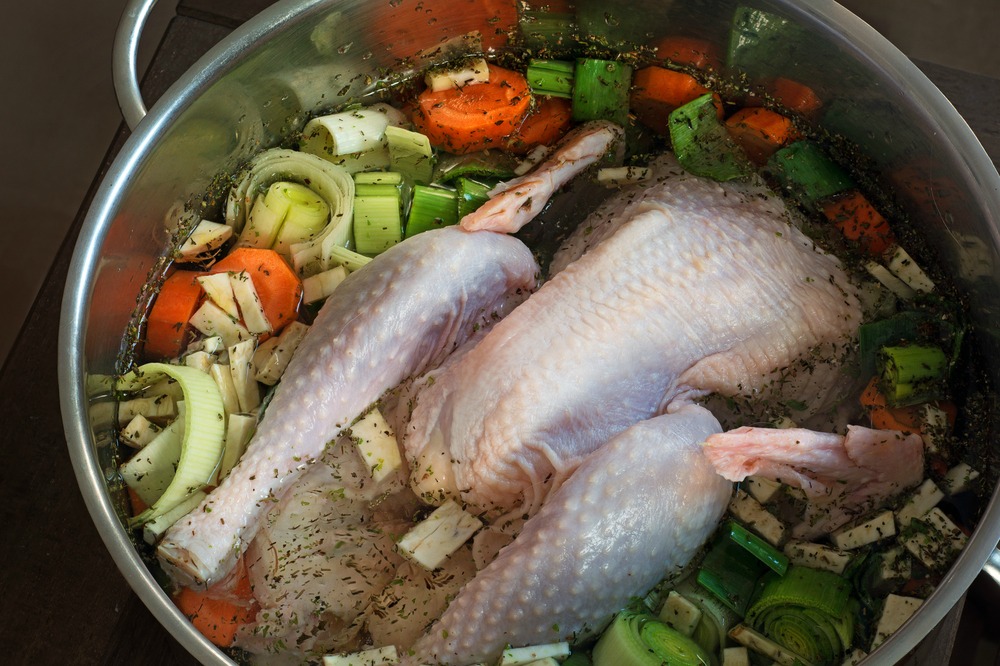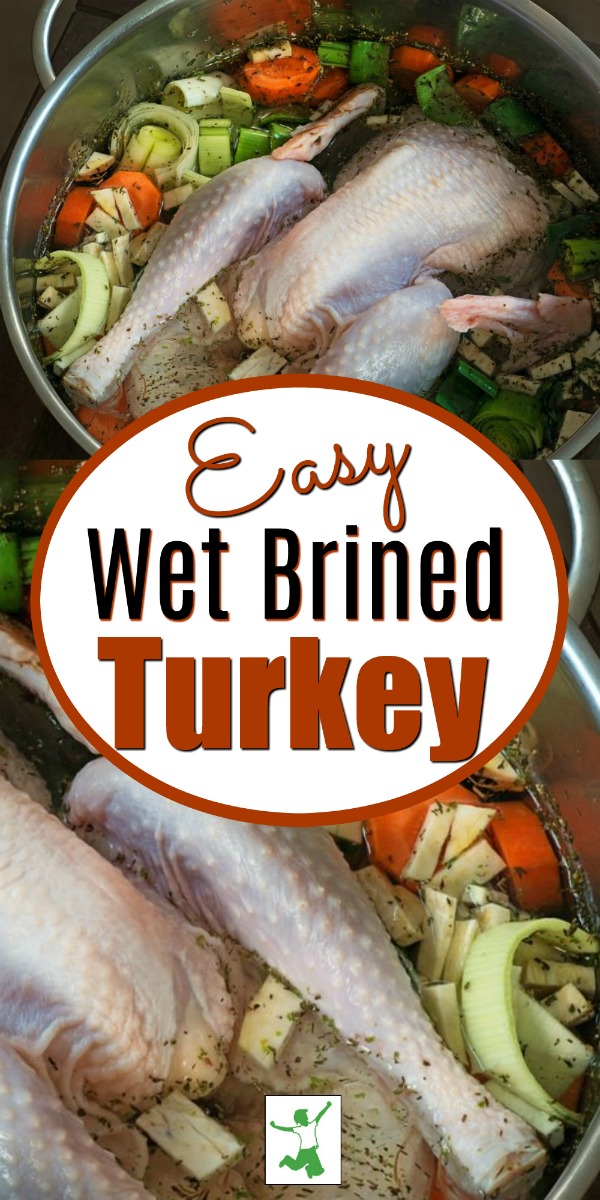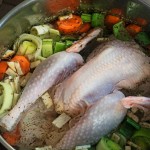The easy process of wet brining a turkey for extra juicy, tender meat that reduces the risks of overcooking considerably. This method is only appropriate for pastured birds as commercial turkeys are injected with (toxic) brine water already.

With each passing year, more people seem to be making the effort to source pastured poultry over conventionally processed birds. Several folks in my neighborhood now raise Thanksgiving turkeys in their backyard! Such a cool trend, don’t you think? If eating pastured turkey is something you would like to try this holiday season, it is a good idea to plan to take the time to make traditional turkey brine and soak your bird before roasting.
Why?
You may have noticed that pastured poultry, both turkey and chicken, tend to be a bit drier than conventionally raised birds unless you cook it exactly right. This is disappointing to some folks until they find out why.
Commercial Poultry Not What it Seems (even if organic)
Did you know that about 30% of the typical, commercially purchased turkey is nothing but saltwater (and not filtered either)? This goes for “natural” and “organic” turkeys too (1).
No, it’s not your imagination that the expensive 18-pound turkey didn’t seem to go very far in feeding your family and holiday guests!
There’s a reason why food producers use injection systems to pump up commercial poultry with a ton of brine solution. This type of processing provides a built-in safety mechanism whereby the consumer can overcook the bird, and it still turns out juicy and tender. Do this with a pastured bird, however, and your goose is literally cooked.
Brine injection also extends shelf life and flavor to birds that are most likely not free-ranging, even if organic, and hence would cook up to be rather tasteless without “flavor enhancement”.
Injected Turkey Brine Contains Toxins, Additives, MSG
The problem with injected turkey and chicken from the store is two-fold:
First, you’re paying a high price for the extra weight that the brine water adds. For example, if you are paying $3.99 per pound for an organic turkey from Whole Foods, and the bird you buy weighs in at 18 pounds, approximately $28 of the $72 total cost of the turkey is for nothing more than saltwater and flavorings.
Kind of a rip-off, don’t you think?
Secondly, the brine water injected into the poultry is not the type of water you want to be consuming in the first place. It’s likely to contain one or more of the following ingredients (2):
- Fluoridated and/or chlorinated tap water.
- Commercial white salt (the type of sodium you want to avoid).
- Sugar (GMO for nonorganic poultry).
- Rancid vegetable oils (GMO in nonorganic turkey) for lean meats.
- Artificial flavor enhancement (aka, “spices”, “organic spices” and “natural flavors” which are pseudonyms for hiding monosodium glutamate, aka MSG).
- Toxic chemicals and binders such as sodium phosphate (prohibited in organic processing but allowed in “natural” poultry).
Avoid the Commercial Turkey Brine and Make it Yourself
Recently, we were talking to neighbor friends about how to ensure a moist, fall off the bone pastured turkey for Thanksgiving. We shared that we planned to roast it slowly in our outdoor barbecue. One idea they suggested was to make our own turkey brine and soak the bird for 24 hours before roasting.
Of course! Such a traditional thing to do and an amazingly simple idea!
If you buy a pastured turkey and eschew store turkey injected with additive-laden brine water to save money and avoid toxins, here’s how to make a healthy solution yourself. This will help ensure that your pastured turkey investment cooks up tender and juicy every time. You won’t ever long for the red button that pops up on commercial turkeys when cooking is “done” ever again!
Turkey Brine Recipe (how to wet brine a turkey)
Important note: Turkey brine is ideally suited to pastured poultry only! Do not wet brine a frozen or fresh commercial turkey, natural or organic, as these birds have most likely already been injected with brine water. Carefully search the label to ensure nothing has been injected before proceeding. Kosher turkeys that have been dry brined should not also be wet brined.
May I suggest that you try charcoal grilling your turkey after you brine it? If you like the taste of smoked turkey, you will love it!
Remember to make homemade turkey broth with the leftover bones after brining, roasting and feasting!


Traditional Turkey Brine Recipe
Pastured poultry requires a 24-hour soak in turkey brine before cooking to ensure tender, juicy results without the injected brine water of commercial birds.
Ingredients
- 1 large turkey 12+ pounds, preferably pastured
- 2 gallons filtered water
- 2 cups sea salt
- 1 cup sucanat or organic brown sugar, optional
- 2 onions preferably organic, use only if you won't stuff the turkey
- 5-6 cloves garlic preferably organic, use only if you won't stuff the turkey
- 2-3 large bay leaf preferably organic, use only if you won't stuff the turkey
Equipment
- 1 large bucket or 5+ gallon stockpot
- sufficient refrigerator space
- 1 brining bag optional, use if you don't have room for a large bucket or stockpot in your refrigerator
Instructions
-
Remove the giblets from the bird and refrigerate. Chop optional onions and garlic cloves.
-
Add the two gallons of filtered water to the large stockpot or bucket. Mix in the sea salt and optional sugar until dissolved. Simmer optional onions, garlic, and bay leaves in a small amount of water for a couple of minutes to stimulate the release of flavors. Do not thoroughly cook them. Cool and stir into the brine water.
-
Place the turkey in the stockpot carefully and ensure that it is fully submerged in the brining liquid. Use a heavy plate or small tray to weigh the bird down and keep it fully submerged if necessary. Placing a small but weighty item into the crevice where the giblets were will also work to weigh the turkey down.
-
Cover and place the container in the refrigerator for at least 18 and up to 24 hours. Flip the turkey once or twice during that time.
-
After brining is complete, remove the turkey carefully, rinse well and place on a large platter. Discard the brine water.
-
Pat the turkey dry with cotton towels. If you have time, let the turkey sit uncovered on a rack sitting on a baking sheet for 2-3 hours before roasting. This is because the skin has absorbed the brine as well as the meat. Drying it off before cooking will help it brown and get crispy like a non-brined turkey.
-
Making gravy from the drippings of a brined turkey can be very salty if you add additional salt during the gravy making process, so don't do this until you've tasted the gravy first!
-
If you will not be roasting the turkey within a few hours, place back into the refrigerator until you are ready to cook it.
Recipe Notes
Use the onions, garlic and bay leaves only if you do not plan to stuff your turkey during roasting.








Do you have to discard the veggies that you brine with?
You don’t have to discard them, but they probably won’t be very tasty afterward.
I found that placing butter under the skin makes the bird super juicy. Stuffing the bird with prunes and vegetables (potatoes, carrots, garlic, onion) mixed with butter and salt makes for a tasty flavor all around. Cover with foil and let the bird cook in the oven, then uncover it at the end and broil the bird for 10 min or until brown. The end result is a juicy sweet/tart turkey. ..yam
Would it be ok to make bone broth with the turkeys bones after roasting if the turkey has been brined?
Yes absolutely. Here is a video how-to in case you haven’t done this before. https://www.thehealthyhomeeconomist.com/how-to-make-soup-stock-from-leftover/
Your photo shows leeks and carrots in the pot but your recipe does not list them in the ingredients. May we therefore add our own favorite spices or is this picture incorrect? Or both?
Yes absolutely use your favorite herbs when brining a pastured turkey (or chicken for that matter). The onion, garlic, bay leaves is a basic suggestion but feel free to change it up however you like.
This recipe looks great. I use a cooler with ice since I never have room in my fridge.
Great idea!